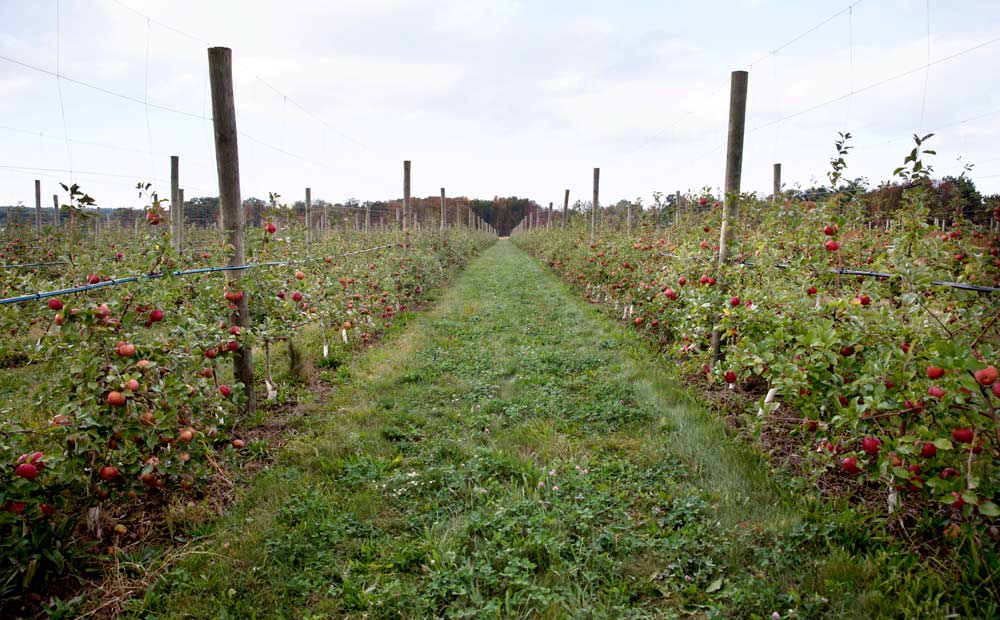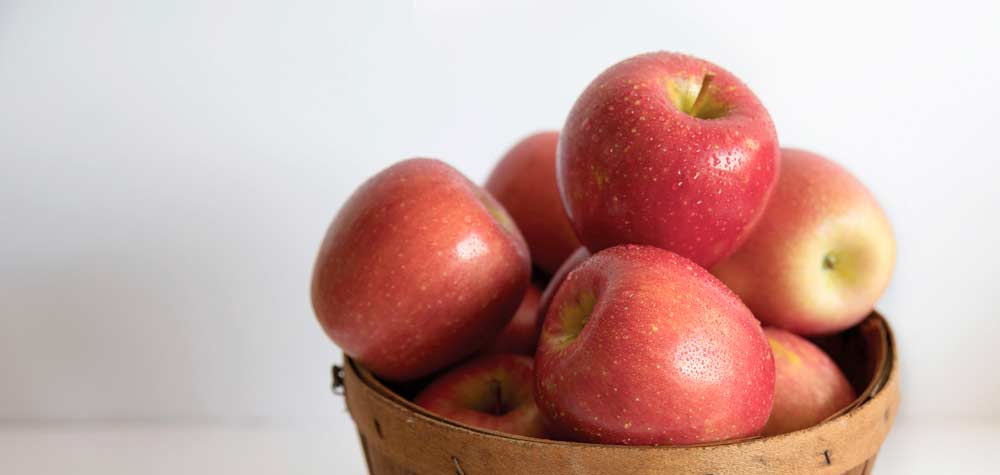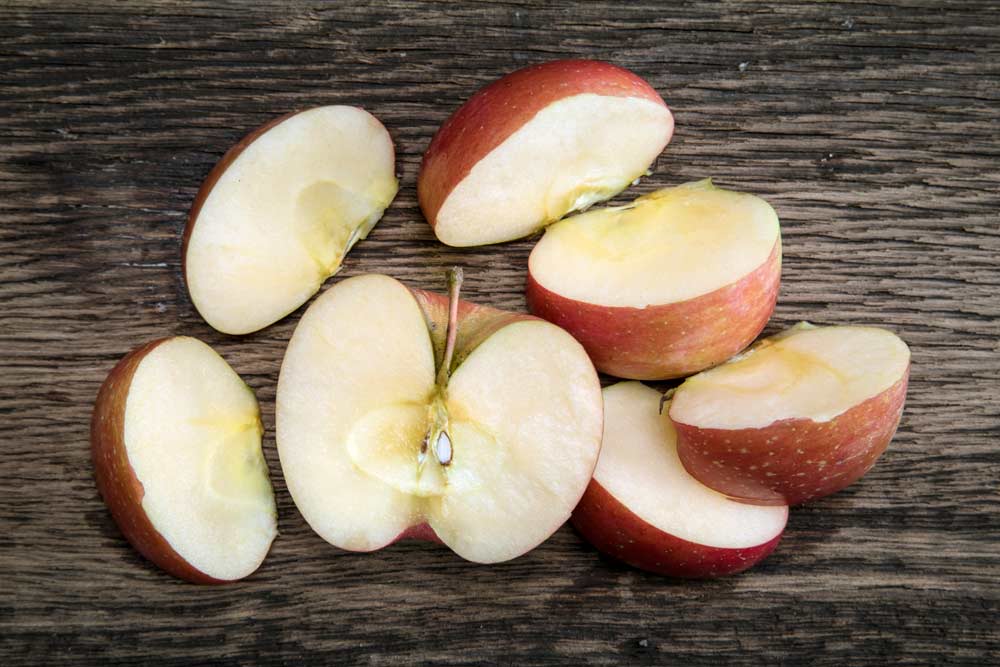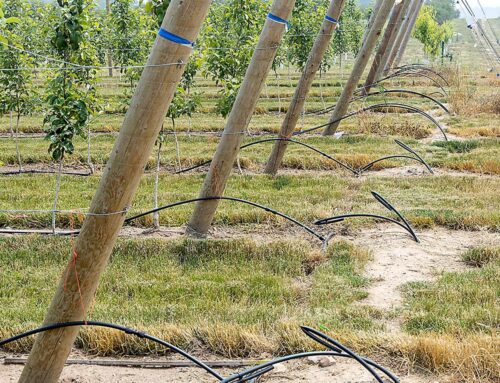
MAIA1 is a grower-friendly tree that doesn’t overcrop or overset, says MAIA president Bill Dodd. The fruit ripens about the same time as Fuji. (Courtesy of MAIA)
The Midwest Apple Improvement Association is working hard to promote its first commercial release: the MAIA1 variety, to be sold under the brand name EverCrisp .
In fact, when Good Fruit Grower contacted MAIA President Bill Dodd in late April, he was just returning from an EverCrisp promotional tour. “Right now, we’re targeting media in certain fresh markets where we will be shipping the apples this fall,” he said.
Marketing is critical now that production is ramping up: Dodd anticipates more than 100,000 cases of the new apples will hit the wholesale market in 2018, and many more will be sold at farm-market and pick-your-own operations.
MAIA has already taken a series of steps to get the apple on the right track. It received a U.S. patent for MAIA1, a U.S. trademark for EverCrisp, and an EverCrisp PLU code, which is critical for retail sales.
It also established a marketing committee last fall to coordinate the promotion of the variety to growers and the apple to buyers and has begun working with a public relations firm to develop a social media plan, refocus the EverCrisp website (evercrispapple.com) to put a heavier emphasis on consumers and organize national media efforts. In addition, the PR firm developed new packaging materials to create a market presence for EverCrisp.
EverCrisp is a “managed-open” release, which means any U.S. grower who becomes an MAIA member and signs a licensing agreement can grow it. MAIA collects trademark and royalty fees that go back into the association’s breeding program.
Asked how the association will enforce EverCrisp standards, he acknowledges that it may be challenging with the managed open release.
“Right now, I don’t have an answer for that, other than we will have to set up a procedure to police it,” he said. But only those apples that meet the marketing and quality standards will be branded and sold as EverCrisp.

Part of the MAIA strategy is to introduce consumers to the apple via small growers and farm markets “and hopefully build momentum into the wholesale marketplace,” Dodd says. (Courtesy of MAIA)
On the global front, the association established a partnership last year with the International Pome Fruit Alliance (IPA) to make the variety available to its members, which include apple and pear marketers and packers in New Zealand, Australia, South Africa, Chile, Europe, as well as the U.S.
The variety is being tested and evaluated in all the IPA member countries, and an international marketing company will be established in 2019 to handle international marketing, according to manager Peter Dall, who is based in South Africa.
“In all our evaluations so far, the tree seems to be grower-friendly with no alternate bearing and highly productive, (and it) stores extremely well,” he said.
The IPA has also obtained trademark registration for EverCrisp in more than 40 countries as of late April, and “by year end, we will have trademark protection in all the major apple-trading countries of the world,” Dall said, noting that the IPA has applied for Plant Breeders Rights in all IPA member countries and will be seeking the same in other apple-producing countries shortly.
Back in the U.S., grower response has been excellent, Dodd said. “There are more than 600,000 trees planted with more going in the ground every year. And there’s been a huge interest in grafting over, so a lot of growers are grafting over or top-working some of the varieties that are falling out of favor, and doing it with MAIA1.”
Dodd said he anticipates accelerating harvest totals for small and large growers.
“Part of our marketing strategy is to allow access to smaller growers, which gives consumers a chance to taste and experience it at the farm level and hopefully build momentum into the wholesale marketplace,” he said. “Growers at the farm market and pick-your-own level don’t report production to us, however, so totals are difficult to measure, but at 600,000 trees in the ground now, and conservatively a bushel a tree, that’s potentially 600,000 bushels of EverCrisp that will be out there in the next couple of years.”
In combination with marketing efforts, MAIA is continuing to release growing and harvest recommendations for the variety and apple — a benefit of being an MAIA member, Dodd said.
“As soon as we learn or make observations about the variety, we share it with you,” he said. “Our goal here is for everyone to be as successful as possible, and the sharing of knowledge is part of that process.”

The EverCrisp apple is a good-storing apple, similar to its Honeycrisp and Fuji parents, and also has some of the texture of Honeycrisp, Dodd reports. (Courtesy of MAIA)
EverCrisp outlook
MAIA President Bill Dodd said the EverCrisp apple is looking great so far.
“It has some of the good storability of both its Fuji and Honeycrisp parents, the texture is similar to Honeycrisp, it’s a pretty grower-friendly tree that doesn’t seem to overcrop or overset, and it has a pretty wide harvest window,” he said.
The variety tends to ripen with Fuji toward the end of the season, which Dodd noted as a bit of a negative, but he added, “The fruit continues to wow and impress us with its flavor and its storability.”
Other MAIA apples to come
Although MAIA1, known as EverCrisp, is in the limelight, the Midwest Apple Improvement Association is also moving forward with four other patented/trademarked and open-release products: MAIA12/Summerset and MAIA11/Rosalee, which are crosses of Honeycrisp and Fuji; MAIAZ/Sweet Zinger, which has GoldRush and Sweet Sixteen parents; and MAIAL/LudaCrisp, an open-pollinated Honeycrisp.
The earliest ripening of the group is Summerset, which is ready to pick at about the same time as Honeycrisp. Rosalee ripens midseason in approximately the Golden Delicious harvest window.
Then come Sweet Zinger, Ludacrisp and EverCrisp, ripening in succession and about a week apart with EverCrisp coming in the latest with a harvest time approximating that of Fuji.
“One of the goals of our breeding program has been to come up with a full harvest season of varieties for our members,” said Bill Dodd, MAIA president, noting that between the four new varieties plus EverCrisp, growers can harvest these apples over six to eight weeks. •
—by Leslie Mertz






I’m a grower in the northern region of Ontario apples. Ordered evercrisp 5yrs ago from Adams county. Hope to have them next year. Honeycrisp grow well on my farm. Good luck to MAIA, which I am a member. We need an apple to recognize out region(the north)